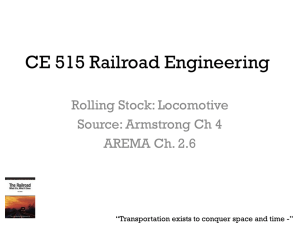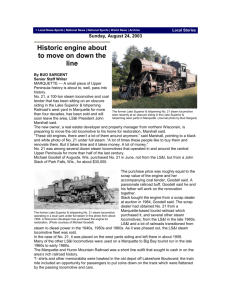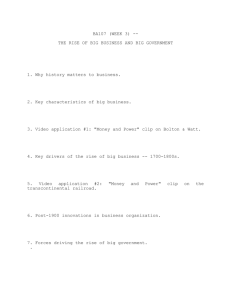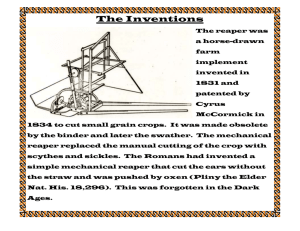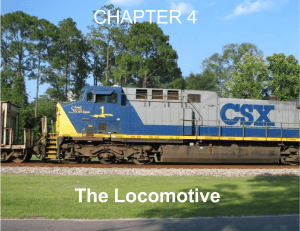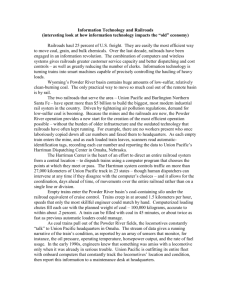All Aboard!!! - the Southeastern Railway Museum
advertisement
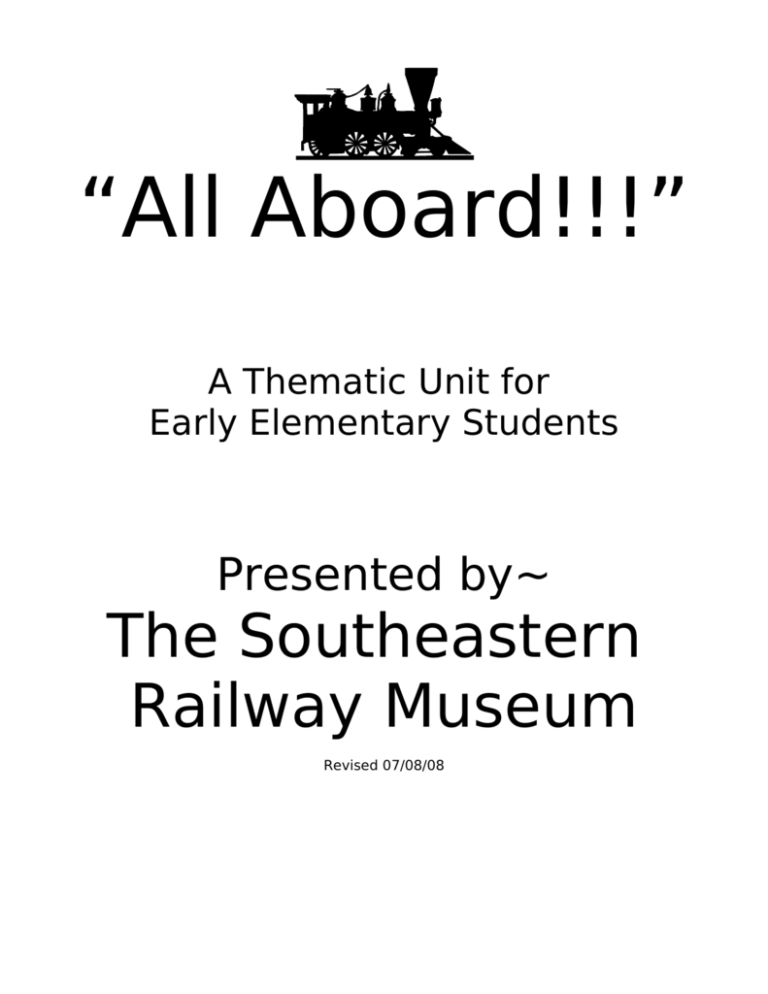
“All Aboard!!!” A Thematic Unit for Early Elementary Students Presented by~ The Southeastern Railway Museum Revised 07/08/08 Georgia Quality Core Curriculum Lesson Plans “Clickity-Clack” Overview of Lesson Students will get to do fun activities related to trains after reading The Little Engine That Could by Watty Piper. They will create a set of boxcars and sing Hap Palmer’s song Clickity-Clack. Students will also follow directions to make a marshmallow train. Georgia QCC Objectives The student will respond to literal, inferential, and evaluative questions about literature. Procedures/Activities Step 1: Tell the children the week before the museum tour that you will be celebrating “Train Week”. Have children wear striped shirts (like conductors). Also have them bring in a shoebox to be used as a boxcar and something for the car to carry (the freight). Introduce The Little Engine That Could by Watty Piper by asking children if they have ever done anything that some people thought they could never do. Ask the children how they felt at the time. Read the book aloud. Ask questions such as those listed in the attachment to this lesson plan to get the children interested in the story and prepared for what to listen for. Discuss the story after reading it by asking how the little engine solved his problem in the story. What other solutions could he have considered? Step 2: Connect the children’s box cars (boxes) with strings that have paper clips tied at each end to connect the cars. Ask the children what each car is hauling. Discuss the different types of goods that freight trains carry. Then pull the train around the room while the children chant, “I think I can, I think I can. . .” Sing Hap Palmer’s song Clickity-Clack substituting the items that the children put in their boxcars in the appropriate place. Step 3: Make marshmallow trains. Use pretzel sticks to hook the boxcars together and peanut butter to glue cheerios on as wheels and other features. Step 4: Make a train track from masking tape all over the classroom. The students are the train. Allow different students to be the engineer, conductor, and the brakeman. Discuss the importance of each of these jobs. Materials and Equipment Book: The Little Engine That Could by Watty Piper Paper clips String Hap Palmer’s song – Clickity Clack Marshmallows Pretzel sticks Cheerios Peanut butter Shoeboxes Masking tape Assessment Use the attached questions to assess story comprehension. Assessment Questions The Little Engine That Could 1. Who wanted to get over the mountain? 2. Why did the toys want to get over the mountain? 3. Why didn’t the other engines want to help? 4. Who decided to help them? 5. Why did the others think that the little blue engine couldn’t help? Here Comes The Train!!! Overview of Lesson In this lesson students will listen to a book about trains, make small human trains, then identify ordinal positions of trains on an assessment sheet. Georgia QCC Objectives The student will use ordinal numbers to indicate positions first through fifth. The student will listen to a variety of literary forms, including stories and poems. Procedures/Activities Step 1: (Teacher Preparation) Print out one copy per child of the Ordinal Train Positions Assessment Sheet. Print yourself a copy of the directions for the assessment sheet (see attachments). Obtain a copy of Freight Train by Donald Crews. Step 2: Call the children to the floor and ask them to sit in a circle. Read the book Freight Train by Donald Crews to the class. Flip back through the book discussing how many cars were on the train – eight; how the train looked going fast – blurry, etc. Step 3: Explain to the students that they will practice making human trains. Call on five students to demonstrate. Have them line up all facing in the same direction. Call on someone to determine who is first in line. Explain that when something is first, there is nothing in front of it. Continue identifying who is second, third, fourth, and fifth. Have the line turn around and face the opposite direction. Ask the children to again identify who is first, second, etc. Explain that when the line or train changes directions it changes the positions of the people. Call on other groups of five to participate. Step 4: After completing the activity, draw on the board a train similar to the one on the assessment sheet. Again, ask a child to identify the first train, second train, etc. Explain that they will complete an activity like this at their seats. Ask them to return to their seats and pass out the ordinal train positions assessment sheet. Have the students complete the sheet while you call out directions. Older kids can use the written directions to follow themselves. Collect papers when finished for assessment. Materials and Equipment Book: Freight Train by Donald Crews One copy per child of the assessment sheet (see attachment) One copy of teacher directions Assessment The teacher will collect the Ordinal Train Positions assessment papers to document whether or not the students were able to identify ordinal positions. Name_________________________________________________________________ Ordinal Train Positions 1. 2. 3. 4. 5. Directions for Ordinal Train Positions 1. Color the first car of the train yellow. Color the fourth car of the train red. Color the second car of the train green. Color the third car of the train blue. 2. Color the third car of the train red. Color the first car of the train green. Color the second car of the train yellow. Color the fourth car of the train blue. 3. Color the second car of the train red. Color the fourth car of the train green. Color the third car of the train yellow. Color the first car of the train blue. 4. Color the fourth car of the train red. Color the second car of the train green. Color the first car of the train yellow. Color the third car of the train blue. 5. Color the second car of the train red. Color the fourth car of the train green. Color the third car of the train yellow. Color the first car of the train blue. The Caboose Who Got Loose Overview of Lesson Students will get to do fun activities related to trains after reading The Caboose Who Got Loose by Bill Peet. They will create a bulletin board related to the story. The students will also sing the song She’ll Be Comin’ Round the Mountain with new lyrics related to trains. The students can also create new endings for the story in a writing workshop. Overview of Book Katy is a caboose, a machine confined to the tracks, but she wants to be free. She doesn’t like being the last car pulled by the big engine up front. It is too noisy, she is afraid of falling rocks, and she doesn’t like the dark tunnels either! Then one day, the coupling breaks, and when Katy goes around a mountain curve, she is flung free. She lands between two evergreen trees and becomes a happy home for birds and squirrels. Georgia QCC Objectives The student will respond to literal, inferential, and evaluative questions about literature. The student will write sentences related to a topic. The student will write for a purpose. The student will use picture clues to make predictions about the literature. Procedures/Activities Activity 1: Talk about trains as machines. Ask the children to describe their experiences on trains. Mention the difference between passenger trains and freight trains. Begin the book by introducing the little red caboose at the end of the train as Katy. Show various pictures throughout the book and have the students predict what will happen next. Read the book aloud. Activity 2: At the end of the story when Katy is stuck in the spruce trees, she looks out and sees a beautiful view. Ask the children to pain Katy’s view from her new home high in the evergreen trees. Let the children help decorate a bulletin board as a big red caboose. Display the paintings on the bulletin board shaped like Katy the caboose. Activity 3: Sing the old folk song, “She’ll Be Comin’ Round the Mountain When She Comes.” Rewrite the lyrics to fit the story of The Caboose Who Got Loose. (See attachment) Activity 4: Have a parent or volunteer come to class to assist the children in assembling a train set. The children can use shoeboxes, Popsicle sticks, and play dough for this project. Discuss the terminology that will be used on the museum tour – label each car, the tracks, and the coupling mechanisms. Activity 5: Read the end of the story again where Katy is stuck in the spruce trees and the squirrels and birds are all around her. Brainstorm different endings for the story. Allow the children to work with partners to come up with a different ending for the story. Materials and Equipment Book: The Caboose Who Got Loose by Bill Peet Easel New lyrics to song (see attachment) Tempera paint White or manilla paper Chart paper Markers Shoeboxes Popsicle sticks Play dough Writing paper Art supplies for illustration New Lyrics To Song She’ll be the last car on the freight train when she comes, Ca-boose. She’ll be the last car on the freight train when she comes, Ca-boose. The last car on the freight train, The last car on the freight train, The last car on the freight train when she comes, Ca-boose. Train Ride Story Web Overview of Lesson After listening to the story, I’m Taking A Train Ride by Shirley Neitzel, students will participate in a fun writing activity. This lesson will allow students to write about a traveling adventure on a train. Georgia QCC Objectives The student will write a minimum of three sentences about a topic. The student will write about a self-selected topic using pictures, letter/sound associations, and known words. The student will use correct spelling for frequently used sight vocabulary. Procedures/Activities Step 1: Introduce the lesson by singing “I’ve Been Working on the Railroad” (see attachment for lyrics). Step 2: Tell the students to pay close attention to the story. It is called a Rebus Story and it uses pictures in place of words. Read the story, I’m Taking A Train Ride by Shirley Neitzel. Review train terminology used in the story (engineer, caboose, conductor, locomotive, etc). Step 3: Write “On A Train Ride” on the board as a title. Under the title, write three subtitles: Where? Who? What? Read the title and subtitles aloud. Now, have the students close their eyes and imagine they are on a train ride. Step 4: Ask the students to brainstorm the following: On a train trip, I went ____________________. I saw _______________. I liked the _____________________. Write the various responses under each title. Repeat until all volunteers have a turn. Step 5: Place the overhead transparency of the Train Ride Web on the overhead (see attachment). Explain that they are going to use this web to write a story about a train ride. Step 6: Using the story web, go through each question and have the students write their responses on the web. Be sure to use the brainstorming session for a resource of data. After the students have completed their web, have them transfer the story to paper. They should illustrate a picture that shows that events in the story. Materials and Equipment Lyrics to song “I’ve Been Working on the Railroad” (see attachment) Markers Book: I’m Taking A Train Ride by Shirley Neitzel Overhead projector and pens Train Ride Story Web (see attachment) Assessment: The assessment of this lesson will be the completed student story. “I've Been Working on the Railroad” Written By: Unknown Copyright Unknown I've been workin' on the railroad, All the live long day. I've been workin' on the railroad, Just to pass the time away. Don't you hear the whistle blowing? Rise up so early in the morn. Don't you hear the captain shouting "Dinah, blow your horn?" Dinah, won't you blow, Dinah, won't you blow, Dinah, won't you blow your horn? Dinah, won't you blow, Dinah, won't you blow, Dinah, won't you blow your horn? Someone's in the kitchen with Dinah. Someone's in the kitchen, I know. Someone's in the kitchen with Dinah Strumming on the old banjo. Fee, fie, fiddle-e-i-o. Fee, fie, fiddle-e-i-o-o-o-o. Fee, fie, fiddle-e-i-o. Strumming on the old banjo. 2 Train Trip Story Web 1 I saw . . . Where would your train go? 2 Who did you see? 3 What did you like about your trip? 1 On a train trip, I went . . . 3 3 I liked the . . . What Makes Steam??? Overview of Lesson Students will discover how steam is formed. Georgia QCC Objectives The student will predict changes in states of matter such as when water is heater or frozen. Procedures/Activities Step 1: Explain to students that in this lesson they will learn how steam is formed. They will be observing how matter can change from one state to another. They will record their observations in their science journals. Step 2: The teacher will demonstrate how boiling water in a teakettle forms steam. The students will hold a small mirror in front of the spout and observe what happens. The students will watch this demonstration and makes observations in their journals. Step 3: Discuss observations. The students may have observed that a “cloud” forms above the spout of the teakettle, that the mirror fogs up and little droplets of water form on the mirror, and that steam is formed when water is heated. Discuss how this relates to a steam locomotive. Materials and Equipment Water Small mirrors Hot plate Teakettle Assessment The student will explain to his or her partner how steam is formed. Exciting Learning Activities Candy Train Craft This candy train is made from a roll of hard candy (like Lifesavers), wrapped peppermint candies, a wrapped caramel, and a wrapped chocolate kiss. Supplies: • Hot glue gun A roll of hard candy (like Lifesavers) 4 wrapped peppermint candies A wrapped caramel A wrapped chocolate kiss • Optional - a short length of yarn or string • • • • Using a hot glue gun, glue four wrapped peppermint candies to a roll of candy; the peppermint candies are the wheels of the train. Glue a wrapped caramel to the top, at one end the train. Glue a wrapped chocolate kiss on top of that. Look at each picture. Each of these people has a special job on the train or at the railroad station. Write a complete sentence to tell how each person makes the train run smoothly. Engineer Porter Conductor Switchman Flagman Be Safe! Railroad Rules To Obey!!! 1) Stop when the gates come down at a railroad crossing. 2) Look both ways before crossing train tracks. 3) Don’t throw anything at a train or on the tracks. 4) Never walk on the rails. 5) Don’t walk between or under train engines or cars. 6) Never get on or off of a train until it has made a complete stop. 7) Don’t play on railroad bridges or tunnels. 8) Stay out of railroad yards and property. Train Songs “The Peanut Song” A peanut sat on a railroad track his heart was all a flutter. Around the bend came number ten, choo-choo, peanut butter. After singing you can give each child a peanut to crack open and eat. "Down by the Station" Down by the station early in the morning, see the little puffer bellies all in a row. See the stationmaster turn the little handle, puff-puff, toot-toot, off we go! “Little Red Caboose” Little red caboose Chug chug chug Little red caboose Chug chug chug Little red caboose Behind the train train train Smokestack on the Back back back Running down the Track track track Little red caboose Behind the train! Vocabulary TRAIN a locomotive and the railway cars connected to it RAILWAY CAR any vehicle with wheels that moves on rails LOCOMOTIVE an engine used to move a railway train TENDER the car attached behind a steam locomotive that carries coal and water for the steam locomotive CABOOSE a car on a freight train, usually the last, used part time as an office, and sometimes used by the conductor, brakeman and crew as living space during a trip (no longer used) TRACK two rails on which the train runs TIE a wooden beam across and under the track; supports the rails FUEL a substance such as wood or coal that will burn to create heat COAL a black rock from the earth that is burned as fuel STEAM water in the form of hot gas, produced when water is heated to boiling STEAM LOCOMOTIVE a locomotive using water in the form of hot gas for power DIESEL LOCOMOTIVE a locomotive using diesel oil to generate electricity for power FIREBOX place for the fire in a steam locomotive SMOKESTACK place where steam and smoke leave the steam locomotive FREIGHT TRAIN a train that carries goods (freight) PASSENGER TRAIN a train that carries people Match each vocabulary word to the correct meaning. 1) two rails on which the train runs ___________________ 2) water in the form of a hot gas, produced when water is heated to boiling _______________________ 3) a train that carries goods ______________________ 4) wooden beams that support the rails _________________ 5) the car that carries coal and water for the steam locomotive ____________________________ 6) any vehicle with wheels that moves on rails ______________________ 7) place for the fire in a steam locomotive _______________ Word Box Freight Train Railway Car Tie Firebox Tender Steam Track "Track Down" the Hidden Words!!! M M S T A J Z A Z E T U V C D E V I T O M O C O L S X O L I BELLS CONDUCTOR ENGINEER PULLMAN TRACK S O E L E F T B J E F N F S V L E N R M A D H L J D M C B P L A G E A I M T G U V F I Y H E Y I R E I S E C I M Y L Y K B U N S B I L T E A E O L N Y Z N E O H F O R S Y C R C E L BERTH DIESEL FREIGHT RAILROAD TRAIN Y L E W T R C X O F U F F C M F C R L Z N F M O A K C I I Y E L E C T R I C B C D K Q X F K X B E R T H O A H M E O V E U S Q Z A N Y R C Q X T D S U C Q R X I T T F N A M L L U P CABOOSE ELECTRIC LOCOMOTIVE STEAM WHISTLES A H N D N V F G A C D K I P T Resources Great Resources!!! Books 1) Thomas the Tank Engine: The Complete Collection by Wilbert Vere Awdry 2) Terrific Trains by Tony Mitton 3) Train Song by Diane Siebert 4) The Little Engine That Could by Watty Piper 5) Inside Freight Train by Donald Crews 6) Train to Somewhere by Ronald Himier 7) Chugga-Chugga Choo-Choo by Kevin Lewis 8) Trains by Chris Oxlade 9) Trains by Neil Morris 10 Train by Christopher Demarest 11) The Little Train by Lois Lenski 12) Puff-Puff, Chugga-Chugga by Christopher Wormell 13) William and the Night Train by Mij Kelly 14) Dinosaur Train by John Steven Gurney 15) The Polar Express by Chris Van Allsburg Videos 1) Choo Choo Trains: Close Up & Very Personal (Stage Fright Productions, c1994) 2) There Goes A Train (Atlantic Group, c1994) 3) Let Me Tell You All About Trains (Traditional Images, c1993) 4) Railroaders: steam, freight, passenger trains and more (Big Kids Productions Inc., c1994) 5) Big Trains, Little Trains (Sandbox Home Videos, c1994) 6) Traveling With Ooga-Booga on Trains (ALA Video/Library Video Network, c1992) 7) Thomas The Tank Engine: The Complete Collection (QFE Home Entertainment, c1991) 8) The Little Engine That Could (MCA Universal Home Video, c n.d.) Transportation History Ancient Approximately 3500 B.C. Wheeled carts are invented. Approximately 3400 B.C. Boats are invented. Approximately 2500 B.C. Horses are tamed and used for transportation. Modern 1680 Christian Huggen designed but never built an internal combustion engine. It was to be powered by gun powder 1769 James Watt patents the steam engine 1783 Joseph Montgofier launched the first hot-air balloon. The balloon ascended to 3,000 feet high and traveled 5 miles in 30 minutes. 1783 Professor J. A. Charles invents the Hydrogen Balloon. 1804 Richard Trevithick built the first locomotive for a road tramway. This was not a railroad. 1807 Isaac de Rivas invented an engine that was powered by hydrogen and oxygen. 1814 George Stephenson builds the first steam-powered engine known as “the rocket”. 1827 A charter was given to the B&O (Baltimore and Ohio) to begin America’s first railroad. 1829 George Stephenson’s engine “the rocket” was used on the Liverpool & Manchester Railway in England 1829 The Liverpool & Manchester Railway in England became the first all steam railroad 1830 The B&O became the first American operating railroad 1830 Peter Cooper builds the “Tom Thumb”, the first American steam engine for the B&O railroad. 1830 B&O railroad goes from Baltimore to Ellicott City 1831 B&O goes from Baltimore to Washington DC 1834 Thomas Davenport invents the first electric car 1858 Jean Lenoir invents and patents a double action electric spark ignition engine fueled by coal gas. 1864 During the War Between the States railroads played a vital role for both sides for moving troops and materials. 1865 George Pullman developed the sleeping car 1866 Frank Sprague invents the axle­hung direct current motor and the principle of gear drive to the axle for use on the Manhattan Electrified Railroad in the United States. 1869 George Westinghouse invents air brakes for trains. 1869 The Union Pacific and the Central Pacific join their tracks on May 10 creating the first trans-continental railroad in the United States. 1877 Nicholaus Otto invented the first 4 stroke engine called the “otto cycle” 1883 Karl Benz produces the first 3 wheel self propelled carriage. 1885 Gottlieb Daimler makes a prototype gas engine. 1890 Wilhelm Maybach builds the first 4 cylinder 4 stroke engine. 1890 – 1910 Hybrid electric cars were produced by Kneger. These vehicles had front wheel drive, power steering and a small gas engine to supplement the battery power 1892 Dr. Rudolf Diesel files a patent on an internal combustion engine based on what is called the compression ignition principle in Augsburg, Germany. 1893 Frank Sprauge invents the first electric trolley (streetcar) 1893 Karl Benz produces the first 4 wheel carriage powered by a 1 ½ horse power engine that is capable of traveling at 15 miles per hour. 1895 General Electric (GE) built its first electric locomotive prototype. However, high electrification costs caused GE to turn its attention to Diesel power to provide electricity for electric railcars. Control issues related to co-coordinating the Diesel engine and electric motor were immediately encountered, primarily due to limitations of the electric elevator drive system that had been chosen. 1898 Adolphus Busch purchases the American manufacturing rights for the Diesel engine in 1898 but never applied this new form of power to transportation. 1903 Orville and Wilbur Wright fly the first internal combustion engine propelled airplane in America. 1908 Henry Ford develops the first mass produced automobile. The Ford assembly line reduced the time to produce the model T from 12 ½ hours to 1 ½ hours and reduced the cost from $950 to $290. 1909 Working with the firm of Klose and Sulzar, Diesel produces the first experimental diesel railroad locomotive. 1911 The General Electric Company sends several of its engineers to Europe to investigate continental experiments with diesel electric motive power. 1912 The world’s first Diesel-powered locomotive was used on the Winterthur-Romanshorn Railroad in Switzerland, but it was not a commercial success. 1913, an experimental 60­horsepower diesel­electric railcar appeared in Sweden. 1914 Hermann Lemp, a GE electrical engineer, developed and patented a reliable direct current electrical control system. Lemp's design used a single lever to control both engine and generator in a coordinated fashion, and was the prototype for all Diesel-electric locomotive control systems. 1917 GE produced an experimental Diesel-electric locomotive using Lemp's control design, the first known to be built in the United States. 1923 the Kaufman Act banned steam locomotives from New York City due to severe pollution problems. The response to this law was to electrify high traffic rail lines. In the mid 1920s, Baldwin Locomotive Works produced a prototype Diesel­electric locomotive for "special uses" (such as for runs where providing water for steam locomotives was scarce) using electrical equipment from Westinghouse Electric Company. Industry sources were beginning to suggest “the outstanding advantages of this new form of motive power.” 1929 the Canadian National Railway became the first North American railway to use diesels in mainline service with 2 units, 9000 and 9001, from Westinghouse. 1929 Westinghouse Electric and Baldwin collaborated to build switching locomotives. However, the Great Depression curtailed demand for Westinghouse’s electrical equipment, and they stopped building locomotives internally, opting to supply electrical parts instead. 1930’s The first regular service of Diesel­electric locomotives was in switching applications. General Electric produced several small switching locomotives. 1930, General Motors Corporation, principally an automobile manufacturer, acquired the Electro Motive Corporation and the Winton Engine Company, the latter an established producer of diesel engines, and from this merger came a much smaller, much lighter diesel engine capable of producing many horsepower. 1933 Ralph Budd of the Chicago, Burlington and Quincy Railroad decided to use the diesel electric type of engine for his railroad's Pioneer Zephyr, a prototype of lightweight, stainless steel, streamlined fast passenger trains. 1934 May 26, the sleek, silver Pioneer Zephyr set off on the return from a trip to Denver to run 1,015.4 miles to Chicago in 13 hours, 4 minutes and 58 seconds, an average speed of 76.61 miles per hour. The three­car articulated train exceeded 100 miles per hour during the trip. 1935, General Motors Corporation began construction of a huge plant for erection of diesel electric locomotives. 1935 The Union Pacific fielded the bright yellow City of Salina, the Atchison, Topeka & Santa Fe purchased from Electro­Motive Corporation a pair of diesels to power the Super Chief between Chicago and Los Angeles. The 1930s ushered in not only the era of the streamlined "lightweight" passenger train, but the era of diesel­ electric motive power for passenger trains as well. 1939 Diesel-electric railroad locomotion entered the mainstream when the Burlington Railroad and Union Pacific used Diesel "streamliners" to haul passengers. 1939 The Electro Motive Division of General Motors (EMD) demonstrates that diesels could practically replace steam locomotives in heavy­duty service. 1939 Following the successful tour of EMD's FT demonstrator freight locomotive set, the transition from steam to Diesel power began. The transition substantially quickened in the years following the close of World War II. 1940 The famous GE "44-tonner" switcher was introduced 1948 The American Locomotive Company built its last steam locomotive. 1949 The Lima Locomotive Works erected its last steam locomotive. 1949 Total Dieselization of the first major American railroad occurred 1953 The Germans produce diesel-hydraulic locomotives. The Germans built a total of 136, V 200, engines. 1960s, 15 diesel-hydraulic locomotives were purchased by the Denver & Rio Grande and Southern Pacific Railroads on a trial basis from the German Kraus-Maffei company. Only the outer shell of one of these exists today, the others having all been scrapped because of mechanical issues. 1969 First manned mission to the moon 1978 First trans-Atlantic flight by a helium balloon 1981 First flight of the space shuttle 1987 First Trans- Atlantic flight by a Hot Air Balloon. 1991 First Trans- Pacific hot air balloon journey.

